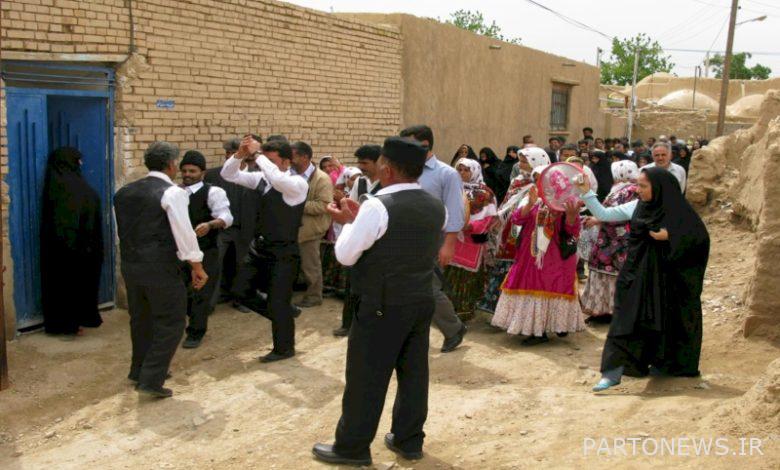Traditional wedding ritual in Semnan

Courtship
In the past, families who had a son, when their son reached the age of marriage, would try to choose a wife for him. The work was the responsibility of the women of the family. If there was a suitable girl among the relatives, they would go directly to the girl’s mother, otherwise they would choose a suitable girl from the neighbors and other families.
After the girl was selected, the girl’s mother was notified through women such as hairdressers or hairdressers or local midwives, and if the answer was yes, two members of the boy’s family would go to the girl’s house to see and measure her. Criteria such as decency and courtesy of the girl were considered. If the girl’s family liked the boy’s family, they would talk to them after a brief reception with fruit tea. But if the girl’s family did not see the boy’s family at all, after having tea, one of the girl’s family members would go to the front door of the room where everyone was sitting and arrange their shoes in front of the door so that guests could see them from inside the room. He would mate outside the room and tell them in a dumb language not to talk any more and welcome. They also left the girl’s house without seeing much talk when they saw their paired shoes outside.
Yes
If the girl’s family seemed to like the boy’s family, they would allow a men’s assembly to be held in the girl’s family with the agreement of the parties, after a few more visits and acquaintances. In this meeting, the amount of milk and dowry and the time of marriage were determined.
The contractors
The marriage assembly was held separately for men and women in the house of a girl and a boy. The women’s marriage assembly was associated with certain rituals and customs. One of the rituals of this assembly was setting the wedding table, which is considered one of the sacred tables in the culture of the people of Semnan. The wedding table was spread out in a large, clean room. Some of the items on the table include a mirror known as the lucky mirror in the middle of the wedding table, two candlesticks with two lights on the sides of the mirror, two eggs, a plate of vegetables and cheese, a cup of honey, a volume of the Holy Quran, a Sangak bread on it. “Happy” was written in black seed, a bowl full of water with green leaves floating on its surface, a plate of narration, a plate of walnuts and so on.
Each of these items has its own mystery, including a mirror for good luck, a candlestick or lamp, a sign of light and longevity, eggs for procreation, cheese and vegetables to repel hoo, honey as a sign of health, a Quran for the virtue of parliament, Sangak bread It was a blessing.
While reading the marriage contract of the two unlucky white women, they looked at the cloth above the bride’s head, and another woman rubbed two pieces of sugar on top of the cloth and repeatedly said, “Oh dear God, love her.”
At the same time, a woman from the bride’s family was constantly inserting and pulling out a knitting needle that was not knotted, and pretending to sew the fabric. The groom’s relatives asked what he was sewing. “I sew love,” he replied.
Dowry seekers
The girl’s family was preparing dowry a few days before the wedding. Of course, some mothers used to buy some dowry items from their savings from their daughter’s adolescence and even childhood. In general, one or two days before the wedding, the device was sent to the groom’s house with special rituals and ceremonies.
The amount and items of dowry were closely related to the economic situation of the families. The small parts of the dowry were placed in several heads or assemblies, and heavy items were loaded on horses, mules, and donkeys and taken to the groom’s house. Upon the arrival of the caravan, the groom’s family sacrificed a sheep with the intention of repelling calamity, fate, and grief, and by praying and reciting songs and chanting, they placed the device in a special room.
At the same time, in order to ward off the sore eyes, they burned the seeds of Pecans and said: “Pecan, a thousand seeds, its smoke on the roof of the house.”
Usually, the bride and groom’s family separately gave sweets and rewards to the people who carried the device. After the wedding ceremony, the wedding date was set. Weddings in the recent past lasted between three and seven days and nights. Hanabandan, bathing of the bride and groom, equipment makers and finally taking the bride was one of the ceremonies that was held during this period.
The culmination of this ceremony was taking the bride, who took the bride to the groom’s house with dancing, singing, dancing, and special rituals.
أنجله (How to bring the bride into the room)
On the eve of the bride entering the room, one of the bride’s in-laws (uncle, uncle, elder brother) tied a tablecloth of bread, cheese and vegetables on the bride’s back or shoulder or waist and tied it from the front and hugged her, kissed her and kissed her on the head. She ran away, and other bridesmaids flocked to her.
* Report from Mohammad Amouzadeh, a researcher of popular culture in Semnan province
.

